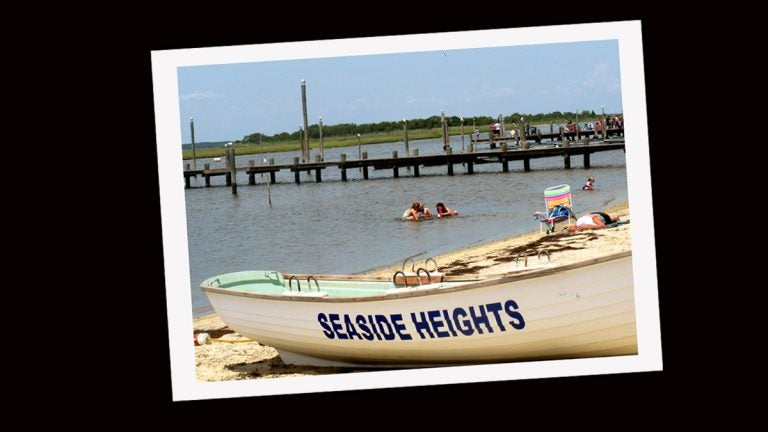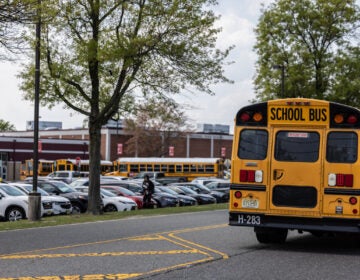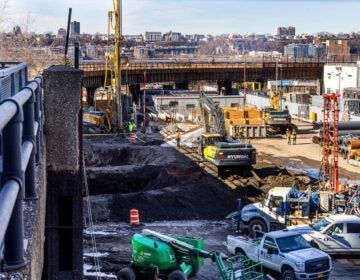Commentary: NJ needs to take action to protect and restore Barnegat Bay

Children play in the shallows of Barnegat Bay in Seaside Heights N.J. on Wednesday, July 11, 2012. A Rutgers University study said that Barnegat Bay has declined over the last 20 years due to pollutants including storm water runoff and fertilizer compounds flushed into its waters. (AP Photo/Wayne Parry)
 Barnegat Bay is beloved by locals and visitors for its many wonderful contributions to the Jersey Shore: swimming, fishing, kayaking, paddle boarding, crabbing, boating, and much more.
Barnegat Bay is beloved by locals and visitors for its many wonderful contributions to the Jersey Shore: swimming, fishing, kayaking, paddle boarding, crabbing, boating, and much more.
But Barnegat Bay is in dire straits. Plagued by frequent algae blooms and disappearing eelgrass habitat, shellfish populations have drastically declined in recent years and have been unable to rebound — a blow to seafood lovers and fisherman alike. Meanwhile, stinging sea nettles have made swimming in its waters a distant memory.
It doesn’t have to be this way forever. The New Jersey Department of Environmental Protection has a major opportunity now to establish stronger protections against the bay’s largest pollution source — stormwater runoff. It is considering changes to the programs that determine how this pollution source is controlled.
Support abounds for the DEP to help protect and restore clean water for Barnegat Bay. Scientists with expertise on Barnegat Bay recently wrote to the agency urging it to focus on stormwater pollution in order to restore the troubled estuary. At the Barnegat Bay Partnership’s recent Science Symposium, Rep. Tom MacArthur (R-NJ) spoke of his efforts to create legislation that will incentivize stormwater improvements to further protect the Bay.
State Sen. Chris Connors and Assembly representatives Brian Rumpf and DiAnne Gove (all R-Ocean) have been leaders in urging the adoption of standards that ensure clean, healthy water through the state’s soil-health law, held in limbo by the Christie administration. Unfortunately developers and other interests don’t want to ensure that new construction meets these standards — even though cost-effective measures are readily available — are standing in the way. The DEP must take strong and swift action to return Barnegat Bay to its former glory. We have waited long enough and soon it will be too late.
Recent studies have made clear that stormwater runoff from the developed landscape, and lawns in particular, is responsible for considerable pollutant loadings to the Barnegat Bay. There are a number of things the state can do to help turn the tide.
First and foremost, by incorporating more cost-effective green infrastructure solutions — things like porous pavement, green roofs, rain gardens, and increased green space — into new construction, we can prevent stormwater runoff by catching rain where it falls. This not only cleans up area waterways and the resulting impacts of pollution, but also helps prevent flooding. And it gives an economic boost to the state’s significant tourism industry, while creating jobs and nurturing a budding sustainable building and green-infrastructure industry.
Second, the state must do what it can to ensure these green-infrastructure measures are done right. A big part of that is ensuring strong soil quality and health after a construction project, or installation of a green-infrastructure measure, such as a rain garden. This means adopting soil restoration standards to reduce post-construction soil compaction and stormwater runoff. Healthy soils will drastically improve water quality and reduce flooding. This initiative was put in motion over four years ago by Gov. Chris Christie as part of his 10-point plan to protect and restore the bay but has yet to be fulfilled.
Third, the state must support its own actions to reduce fertilizer runoff from the land areas that is carried into waterways when it rains. On a positive note, the state is on its way with a new fertilizer law. While it was an important first step in reducing excessive application of fertilizer, its effectiveness is compromised if it’s not backed up with soil restoration standards. To succeed, the fertilizer law and soil restoration law must work in concert to prevent pollution from entering the state’s waterways.
Lastly, current stormwater standards allow developers to disturb the natural landscape — tearing out our natural green infrastructure — and those bad practices should end. Undisturbed forested areas, which serve as habitat for wildlife and provide many other benefits, should not be cleared and replaced with nonfunctioning stormwater basins that discharge into area waterways. As much as possible, the state’s standards should promote conservation of woodland areas, which can effectively and naturally filter rainwater.
We strongly support the scientists, state legislators, and local congressional representatives who worked to protect clean water, beaches, and Barnegat Bay. The Jersey Shore and the bay bring in billions of dollars every year to the Ocean County and state economies.
The state must seize this important opportunity to restore our waters, reduce flooding, and protect wildlife habitat by adopting new, stronger standards to prevent stormwater runoff pollution.
Helen Henderson is the Atlantic Coast project manager for the American Littoral Society.
____________________________________________________________
NJ Spotlight, an independent online news service on issues critical to New Jersey, makes its in-depth reporting available to NewsWorks.
WHYY is your source for fact-based, in-depth journalism and information. As a nonprofit organization, we rely on financial support from readers like you. Please give today.




